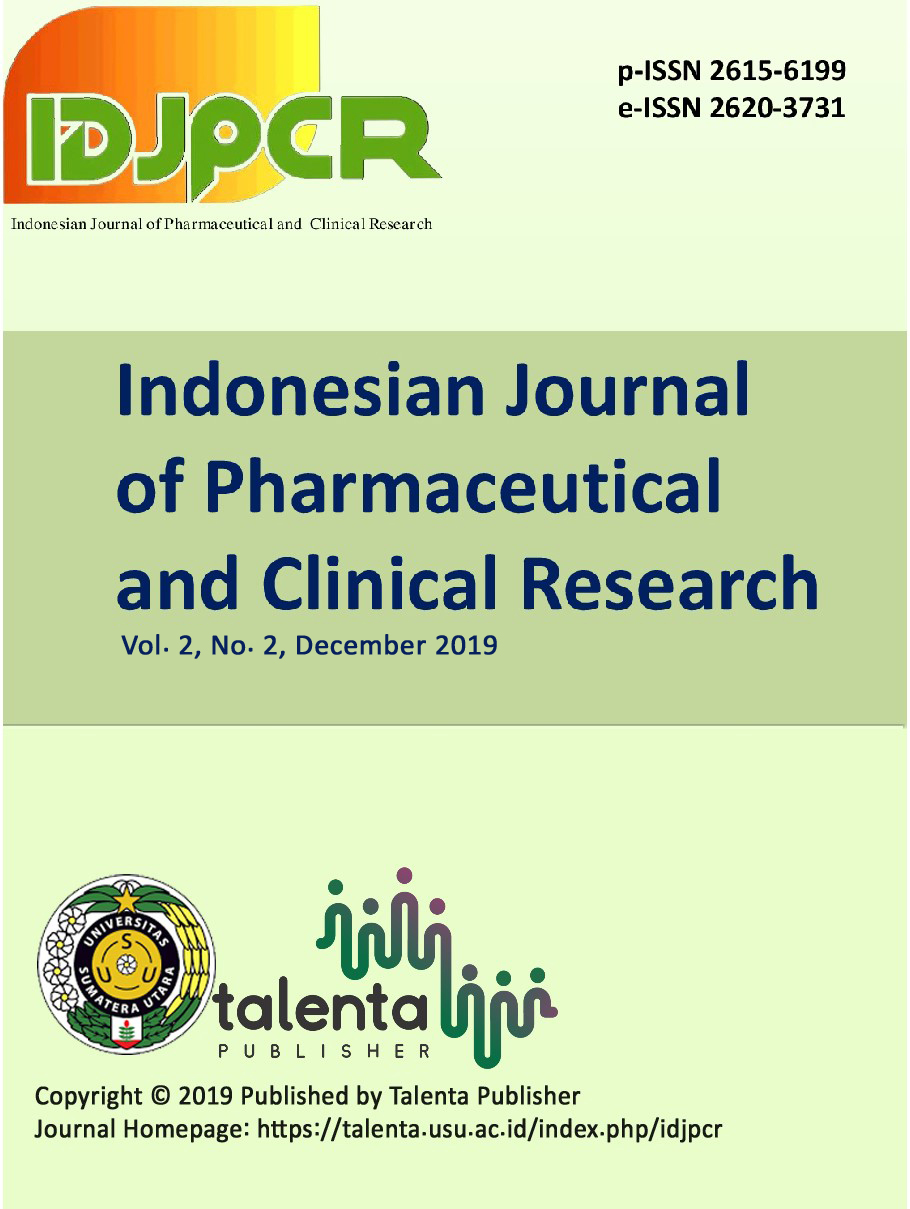Comparison of Antioxidant Activity of Ethanol Extract of Fruit and Okra Leaves (Abelmoschus esculentus L. Moench) with DPPH and ABTS Methods
DOI:
https://doi.org/10.32734/idjpcr.v2i2.2815Keywords:
Antioxidants, DPPH, ABTS, Abelmoschus esculentus (L.) MoenchAbstract
Excessive free radical activity in the human body can be characterized by pathological conditions such as cardiovascular disease, pre-natal complications, arthritis, cataracts, parkinsonism, alzheimer's, and aging. One way to prevent the formation of free radicals is to use nutrients that act as antioxidants. Natural antioxidants found in fruits and vegetables are effective free radicals and are considered non-toxic when compared with synthetic antioxidants, one of which is the okra plant Abelmoschus esculentus L.The purpose of this study is to determine differences in the antioxidant activity ethanol extract of fruit and okra leaves with DPPH method and ABTS method. The method used in this study is the maceration extraction method with 70% ethanol solvent to obtain fruit extracts and okra leaves. The antioxidant activity test was carried out by the DPPH (1,1-diphenyl-2-picrylhydrazi) method by measuring the absorption of a mixture of sample extracts and DPPH by UV-Visible spectrophotometry at a wavelength of 520 nm and by the ABTS method ((2,2-azinobis- (3 -Ethylbenzothiazoline-6-Sulfonic Acid) by measuring the absorption of a mixture of sample extracts and ABTS by UV-Visible spectrophotometry at a wavelength of 734 nm. measurement of antioxidant activity of okra fruit ethanol extract by ABTS method has very strong antioxidant activity (IC50 24.50 ppm)
Downloads
References
2. Dewi NWOAC, Puspawati NM, Swantara IMD, Asih IARA, Rita WS. Aktivitas Antioksidan Senyawa Flavonoid Ekstrak Etanol Biji Terong Belanda (Solanum betaceum, syn) dalam Menghambat Reaksi Peroksidasi Lemak pada Plasma Darah Tikus Wistar. Cakra Kim (Indonesian E-Journal Appl Chem. 2014;2(1):9.
3. Fitriana WD, Fatmawati S, Ersam T. Uji aktivitas antioksidan terhadap DPPH dan ABTS dari fraksi-fraksi daun kelor (Moringa oleifera). Simp Nas Inov dan Pembelajaran Sains Bandung. 2015;657–60.
4. Setiawan F, Yunita O, Kurniawan A. Uji Aktivitas Antioksidan Ekstrak Etanol Kayu Secang (Caesalpinia sappan) Menggunakan Metode DPPH, ABTS, dan FRAP. Media Pharm Indones. 2018;2(2):82–9.
5. Pietta P-G. Flavonoids as antioxidants. J Nat Prod. 2000;63(7):1035–42.
6. Pertanian BPT. Budidaya okra dan kelor didalam pot. Balai Besar Pengkaj dan Pengemb Teknol Pertan Badan Penelit dan Pengemb Pertanian Jakarta. 2016;
7. Hasibuan PAZ. Aktivitas Antioksidan dari Ekstrak Etanol Daun Okra (Abelmoschus Esculentus Moench.). 2017;
8. Serlahwaty D, Sevian AN. Uji Aktivitas AntiOksidan Ekstrak Etanol 96% Kombinasi Buah Strawberry Dan Tomat Dengan Metode ABTS. In: Proceeding of Mulawarman Pharmaceuticals Conferences. 2016. p. 322–30.
9. Indonesia KKR. Suplemen III Farmakope Herbal Indonesia. Ed I, Kementrian Kesehat RI, Jakarta. 2013;
10. Burits M, Bucar F. Antioxidant activity of Nigella sativa essential oil. Phyther Res. 2000;14(5):323–8.
11. Shalaby EA, Shanab SMM. Comparison of DPPH and ABTS assays for determining antioxidant potential of water and methanol extracts of Spirulina platensis. 2013;
12. Molyneux P. The Use of The Stable Free Radical Diphenylpicryhydrazyl (DPPH). For Estimating Antioxidant Activity. Songklanakarin. J Sci Technol 26 211. 2003;219.
13. Blois MS. Antioxidant determinations by the use of a stable free radical. Nature. 1958;181(4617):1199.
Downloads
Published
How to Cite
Issue
Section
License
The Authors submitting a manuscript do so on the understanding that if accepted for publication, copyright of the article shall be assigned to Indonesian Journal of Pharmaceutical and Clinical Research (IDJPCR) and Faculty of Pharmacy as well as TALENTA Publisher Universitas Sumatera Utara as publisher of the journal.
Copyright encompasses exclusive rights to reproduce and deliver the article in all form and media. The reproduction of any part of this journal, its storage in databases and its transmission by any form or media, will be allowed only with a written permission from Indonesian Journal of Pharmaceutical and Clinical Research (IDJPCR).
The Copyright Transfer Form can be downloaded here.
The copyright form should be signed originally and sent to the Editorial Office in the form of original mail or scanned document.









